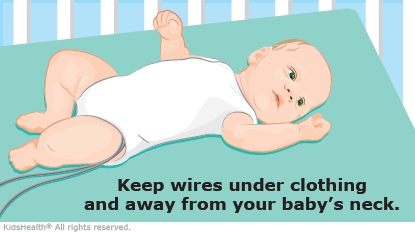An apnea monitor sounds an alarm to let you know when your baby has pauses in breathing (called apnea) or a slower heart rate (called bradycardia). The monitor keeps a record of apnea and bradycardia episodes. Your baby's health care provider can look at this record to help understand how your baby is doing.
Apnea monitors sometimes have false alarms. This means that the alarm goes off, but the baby did not really have apnea or bradycardia. It may happen if the apnea monitor is not set up or working correctly or if the baby is only moving their chest a little bit to breathe (shallow breathing). Even if false alarms happen often, never ignore an alarm.


Follow the manufacturer's instructions for setting up the monitor. Use the apnea monitor when your baby is asleep or out of your sight, and keep wires under clothing and away from your baby's neck. It is OK to take your baby off the monitor when you and your baby are together and both awake.
Follow these tips when using the monitor:


Your baby:

Your baby is:
If your baby does not get better with gentle stimulation, start CPR and call 911 immediately.

Who has episodes of apnea? Apnea can happen in premature babies (those who were born early), but it also happens in babies who were born on time. Some medical conditions (such as problems with the heart or nervous system) can make it more likely that a baby will have apnea.
How does an apnea monitor work? Wires connect patches on the baby's chest (the sensors) to a monitoring unit. The sensors on the chest measure chest movement (breathing) and heart rate. If your baby's chest stops moving for a certain amount of time or their heart rate slows, an alarm goes off.